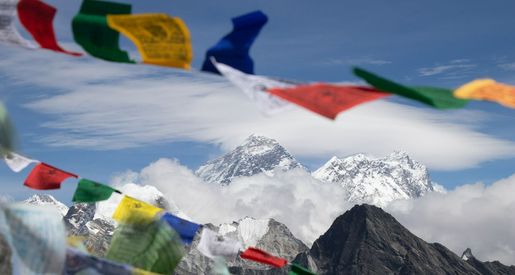- Details
- Category: Knowledge Centre
Best Festivals in Nepal
Not only is Nepal AWESOME and the best place in the world for spectacular high altitude treks, it also offers more opportunities for cultural enrichment than you can shake a trekking pole at. When your eyes are not staring at the immense beauty of the Himalayas, you might seek the path to enlightenment in a Buddhist monastery, dance in the streets with the local Nepalese children, or indulge in a spot of afternoon yak(Female Yak is a Nak)-butter tea with a friendly local herder.
But if you really want to get to know the country and get in with the Nepalese in-crowd and grab some real culture, there’s no better way than to get involved in any of the country's festivals. Lucky you – you’re spoiled for choice; the Nepalese clearly enjoy a good celebration, so you’re likely to find a top-notch festival or event nearby at almost any time of the year.
Here's our pick of the best Festivals in Nepal and don’t forget to pack your dancing trousers.
Dashain (Late September/October)
As events and festivals in Nepal go, Dashain is the biggie and a cultural experience without equal. Spanning a full fifteen days, the festival of Dashain is celebrated by Hindus and Buddhists throughout Nepal. What’s happening here in this joyful extravaganza is that the populous of Nepal is celebrating an essential triumph of good over evil; and what better excuse could there be for a humongous nationwide party?
Dashain has its roots in Hindu religious lore, and celebrates the vanquishing of the demon-king, Ravana and the demon Mahishasura by the Hindu goddess Durga. Anyway, the upshot for the modern festival-goer in Nepal (that’s you, by the way) is that Dashain offers loads of culture and fun; you’ll likely find fun fair attractions in many towns and cities, kite flying is traditional, there are plenty of music events and, in the cities of the Kathmandu Valley you can be swept along by impressively colourful processions in which statues of Nepalese and Hindu gods are carried aloft.
One small word of warning: different cultures, different rules – animal sacrifice is part of Dashain tradition; it’s all about appeasing the Hindu goddesses, you see, but if this is likely to upset or offend you it can be avoided. This mostly happens on the eighth day of the festival so you might want to plan ahead and arrange to be on a high altitude trek somewhere rather than be in town that day.
Holi: aka ‘Festival of Colours’ (February/March)
Things get messy in this one, but in the nicest, most fun way possible. One of the liveliest of Nepal’s cultural events – and definitely the most colourful – the Hindu festival Holi celebrates the arrival of spring and (in brief) the defeat of another naughty Hindu demoness called Holika.
Despite having religious connotations, Holi is unusual in that it demands no religious activity of its participants: this festival is all about fun. Messy fun. And it’s almost impossible not to get caught up in the action and have an amazing experience. What’s so great about Holi is that everyone, young or old, takes part in a day of utter mischief and revelry – people throw waterbombs with brightly coloured payloads at each other, powdered paints are liberally showered over crowds, paint is smeared on faces and everyone has a great time looking like smiling rainbows.
Here's some advice from us: if you want to experience Holi to the max (and trust us, you do) you’ll have a great time in the bigger towns and cities: so - Kathmandu, Pokhara, etc. If you’re doing it properly your clothes, face, hair and belongings are going to end up technicoloured so you might not want to wear brand new designer 'North Face' gear. The action mostly takes place between 10am and 3pm so you’ll have time to get a much-needed shower and change in the afternoon before more partying in the evening.
Indra Jatra (September/October)
Ever wondered what a living goddess looked like? You’ll have to be in Kathmandu in September to find out. That’s when the exciting celebration of ‘the Lord of the Rain’ – Indra - takes place. Coincidentally, of course, it also happens to be at the end of monsoon season; that’s got to be a good omen if you’re here for the trekking.
Indra’s one of the more interesting Hindu gods; in charge of rain and thunderstorms he rides a white elephant and carries a lightning rod. He’s also pretty important – the Indra Jatra festival lasts eight days.
One of the highlights is the opportunity to see Kathmandu’s living goddess (known as ‘Kumari’); a tough gig that can only be awarded to a Nepalese girl aged between two and four from the Kathmandu Valley who meets a demanding checklist of goddess selection criteria.
Mani Rimdu (October/November)
Mani Rimdu is a 19-day sequence of sacred ceremonies culminating in a 3-day public festival. It's an opportunity for the local Sherpa and Tibetan communities, to gather and celebrate together with the monastic community. If you're lucky enough to be trekking through Tengboche on the Everest Base Camp route during this 3 day period, you will experience something amazing and special.
It is divided into six parts or segments;
- Construction of the Mandala -The first day consists of preparations including making the sand Mandala and Tormas (symbolic offerings made of colored butter and barley flour)
- The Empowerment (Wong) -It is the opening public ceremony performed on the full moon day by Trulshig Rinpoche. The sacred pills, (Rimdu or Mani Rilwu) and Tshereel (pills for long life), are distributed among attendees.
- The Dances (Chham) -Chham is a sacred dance ceremony offered for spiritual purposes but public entertainment
- Ser-Kyem -It is a group dance consisting of six dancers who offer spiritual drink to the Earth deities.
- The Fire Puja (Jinsak) -The fire puja is performed in the monastery’s yard to ward off evil and to make offerings to the Fire god “Agni”
- Chhingpa -It is the final day celebration which involves spiritual singing and dancing.
The final day is when the ritual is concluded by a special blessing ceremony offered only by the Tengboche Rinpoche to the public. During the occasion, the renowned Mask Dance is also performed by the monks of the Monastery.
If you want to see this festival in all it's glory, we operate treks in October & November each year and can organise additional accommodation to stay in Tengboche for the 3 day public event.
Previous Articles
- How to Train for the Everest Base Camp Trek
- How high is Everest Base Camp?
- How much spending money do you need for the Everest Base Camp trek
- What's the accommodation like on an Everest Base Camp trek
- Are showers available on the Everest Base Camp trek?
- What type of toilets are available on an Everest Base Camp Trek






